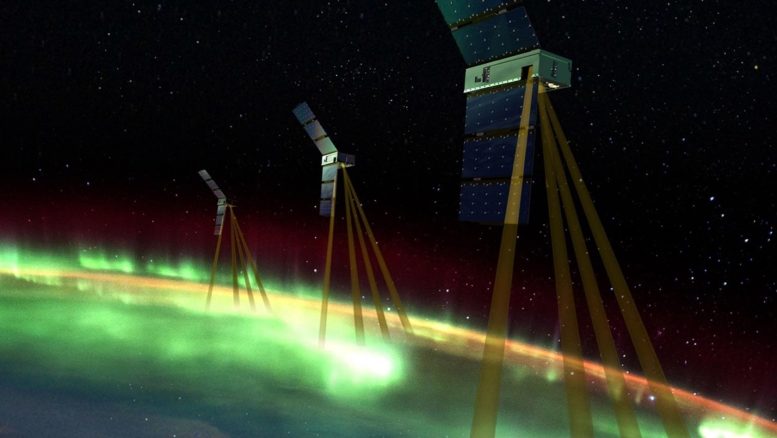Un hito en la misión EZIE de la NASA para estudiar las corrientes eléctricas en la atmósfera superior de la Tierra
Esta ilustración muestra tres CubeSats en la misión EZIE de la NASA volando en formación sobre la Tierra. La nave espacial estudiará las corrientes eléctricas en la atmósfera de la Tierra que relacionan los cambios en la magnetosfera con los efectos en la superficie de la Tierra durante las tormentas geomagnéticas, las mismas tormentas que desencadenan coloridas auroras. Crédito: NASA/Johns Hopkins APL
space weather — magnetic events in space that can affect our ever increasingly technological society.
EZIE will fly three identical CubeSats that will orbit the globe in a pearls-on-a-string formation when it launches, which will be no earlier than September 2024. Each spacecraft will measure the electrojet current by imaging its “fingerprint.” The spacecraft will look at light being emitted from oxygen molecules below the electrojets at just 50 miles (80 kilometers) above the surface. The spacecraft will do this by exploring a phenomenon called Zeeman splitting, which is the splitting of a molecule’s light spectrum when placed near a magnetic field. Doing this means they can derive the magnetic field created by the electrojets as they flow and, in turn, detect the electrojets’ current. This new application of the Zeeman effect will allow scientists to infer the magnetic field produced by an electrojet current in the overlying ionosphere and, in turn, learn how the size and strength of these electrojets change when solar storms impact the magnetosphere.
Funding for EZIE comes from the Heliophysics Explorers Program, managed by the Explorers Program Office at NASA’s Goddard Space Flight Center in Greenbelt, Maryland. The principal investigator for the mission is Jeng-Hwa (Sam) Yee of the Johns Hopkins University Applied Physics Laboratory in Laurel, Maryland. NASA’s Jet Propulsion Laboratory will build the satellite instruments. Blue Canyon Technologies will provide the spacecraft and mission operations center, and it will perform systems integration and testing as well as mission operations. Maverick Space Systems will provide launch and deployment operations.

“Defensor de la Web. Geek de la comida galardonado. Incapaz de escribir con guantes de boxeo puestos. Apasionado jugador”.

